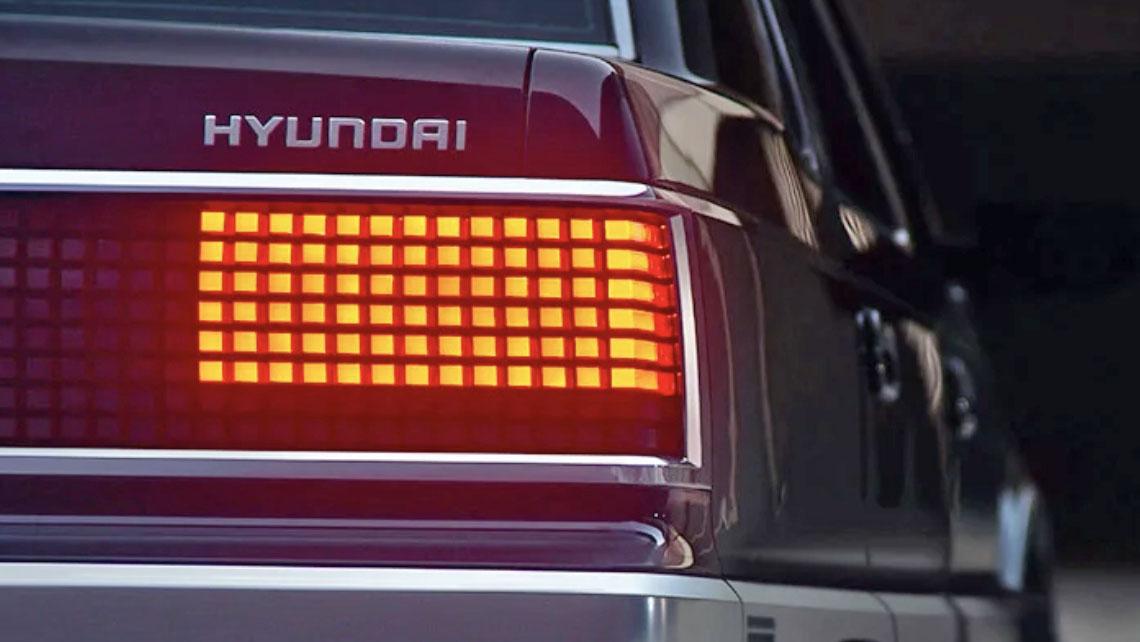Every website from Attic Insulation Digest to Yak Fondler Weekly has covered the Hyundai Grandeur; the internet is awash with facts and figures about the Korean brand’s latest concept car, so I’m not going to put any here. Frankly, none of that minutiae matters – it’s never going to be series-produced anyway. More important, from where I’m sitting, is that they thought to build it.
The Hyundai Grandeur Heritage Series EV makes me nostalgic for an exciting future, one quite different from the arguably more exciting one we actually ended up with. A time when there were endless possibilities to come – rather than everything is possible right now.

You could see the GHSEV (as nobody is calling it) as a continuation of the 1986-launched Mitsubishi Debonair clone original. An extra-top-of-the-range, flagship-plus Grandeur that’s crammed with features that weren’t possible then but are today. “No, I’ll hold off for now and not order the 1986 Grandeur GL (or whatever the top trim level was), I’ll order your Heritage Series EV and accept the 35 year wait for it to be built. What’s the rush?”.
This thing is tuned directly into my mind. Back in the 80s, concept cars were pretty much the meaning of life. More or less my religion. I’m 40 now, so when I was a kid, concepts like the Nissan CUE-X (infinitely more interesting than its Nissan QX homonym) enthralled me, with features like electronic air suspension, drive-by-wire control, anti-lock brakes, a laser/radar based cruise control system, a colour touchscreen infotainment screen and matching digital instrument panel, and much, much more. All of that seemed like science fiction. Of course, today, none of those features are anything special. In fact, they’re pretty mundane.
In fact, technology is now so advanced that we’ve reached a point where it’s really hard for me to imagine an interesting automotive fantasy concept car. Once upon a time, the idea that a car would be able to look after the steering, acceleration and braking on your behalf seemed like the most incredible, Knight Rider-esque fantasy. Now it’s arrived, I tend to switch it off. Even going really fast has become mundane.
The Hyundai Grandeur Heritage Series EV reminds me of a time where we were used to suspending our disbelief. A time when Disney animations were still at least partially hand-drawn, and the computer-animated bits stood out and the whole cinema went “whoa” in unison.

Think of Flight of the Navigator. That bit where the Dymaxion drone ship flies over the Everglades at many times the speed of sound, at low altitude, with bits of Florida reflecting on its chrome flanks. That was one of the few computer animated bits in the whole film, because the technology was so expensive. And it was amazing, blending seamlessly with the live action.
Back to the Future used hardly any of what we’d call computer animation today. Universal did the best they could with the technology they had at their disposal, and they did an amazing job. We didn’t question a thing. The same with the obviously hand-drawn and /or puppet-based beasts in Ghostbusters. We turned a blind eye to the oddly limp, proportionally dubious creatures. We suspended our disbelief.

Nowadays, something akin to perfection is possible in digitally animated films. In fact, such a standard is so easy to attain that the technology is thrown around with gay abandon. To such an extent that it’s so ubiquitous as to become tedious. Witness Transformers. Yes, there’s an awesomeness of spectacle, but once you’ve seen five minutes of the impossible and gone “wow” a bit, the next hour of basically the same becomes something to endure.
I loved Star Trek, The Next Generation. I loved that the main console of the Bridge of the Enterprise was trimmed in wood veneer, which made it relatable to the current, but how the touchscreens they were using – while feasible – used a technology that was just beyond the horizon. Yet the three year-old smartphone I have in my pocket is actually wildly advanced compared with anything they dreamt up in TNG.
Back to the Hyundai. I suppose what I like about it is how it defines what progress actually is. By using the anachronistic, oldentimes shape of the Grandeur, the concept delineates what already exists and what’s new and exciting. Whereas the innovation in the Ioniq 5 – which seems to be specced almost identically – is kind of lost in a sea of white noise, it stands out starkly in the Grandeur.
It’s fucking awesome, too, seemingly channelling Bladerunner in all the right ways and posessed of an interior that I would quite happily spend the rest of my life in. It is, for me, by far and away the most appealing concept I’ve seen in years.
And imagine if the concept behind this concept car is Hyundai offering to retrofit its latest EV tech to existing cars, with the Grandeur merely offered as a serving suggestion? If this were the case, I’d sure as hell be taking my Rover to a Hyundai workshop.




Leave a Reply